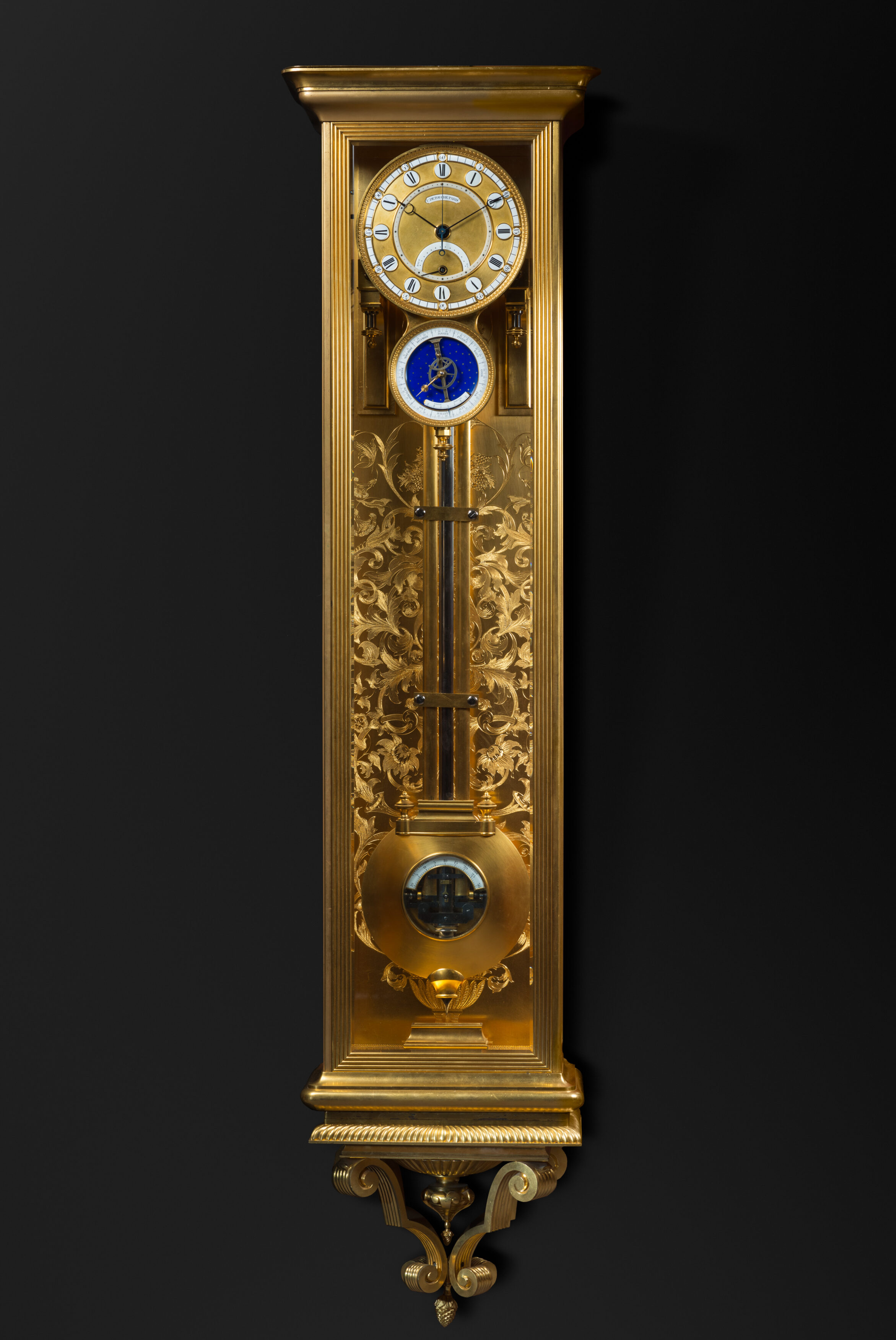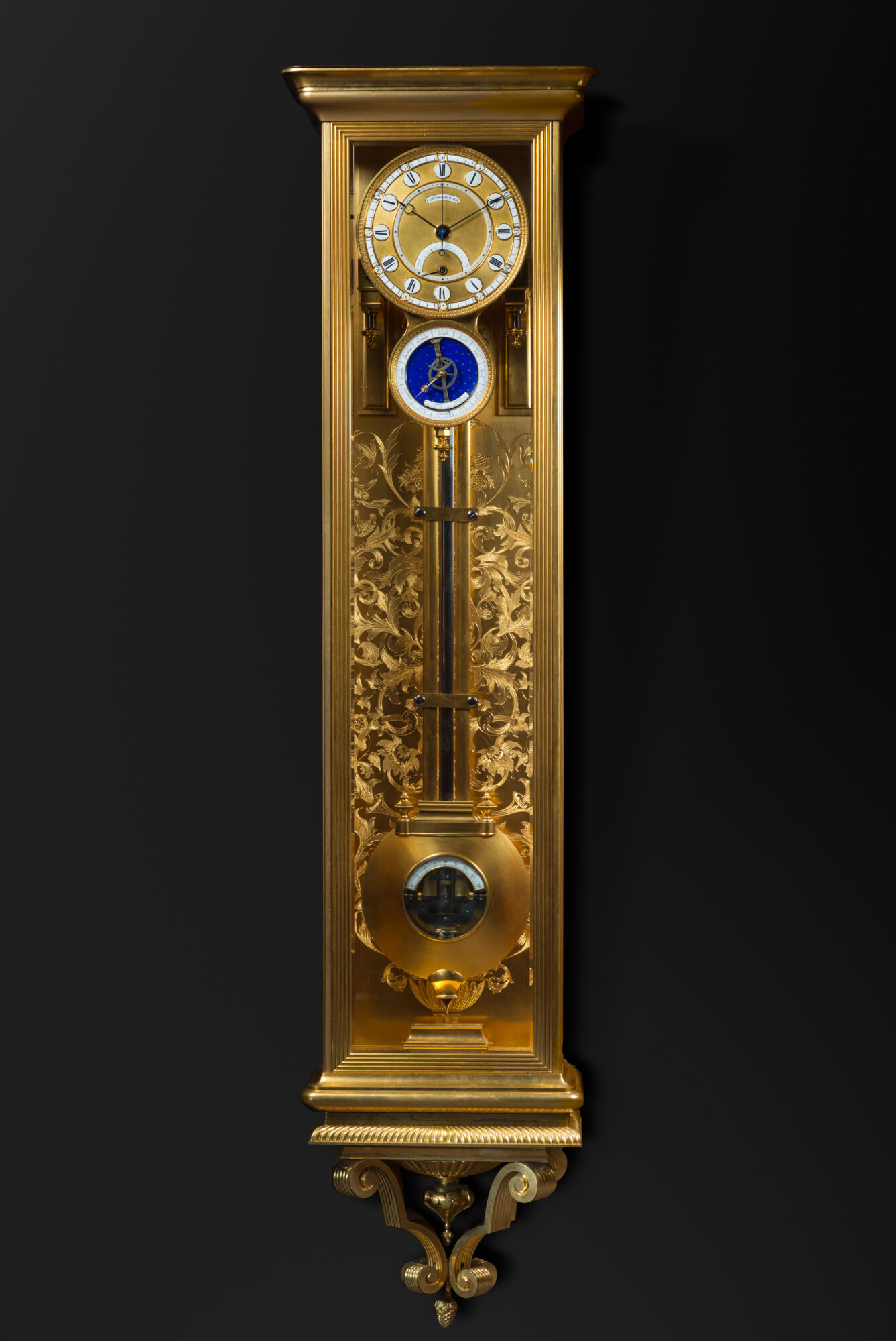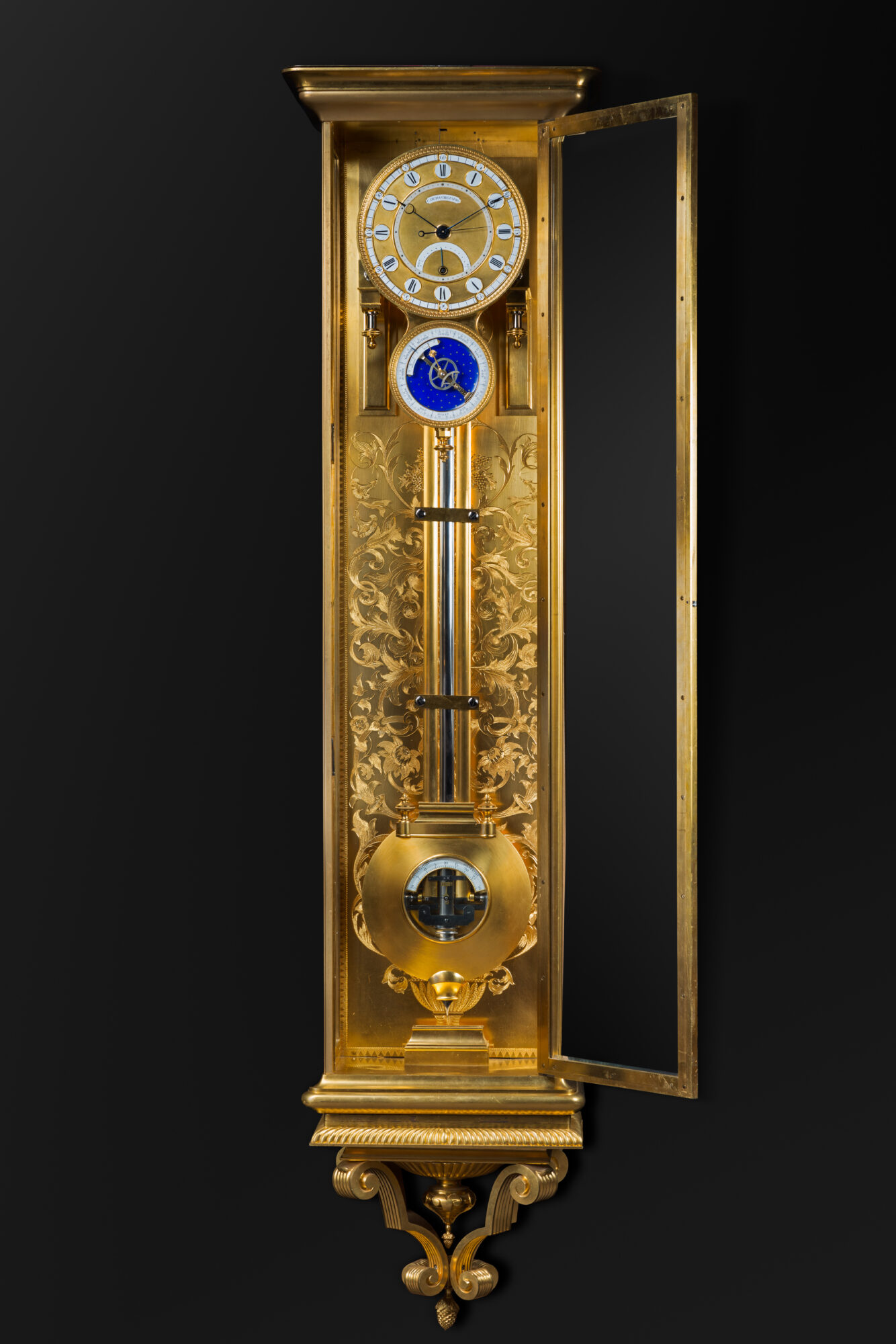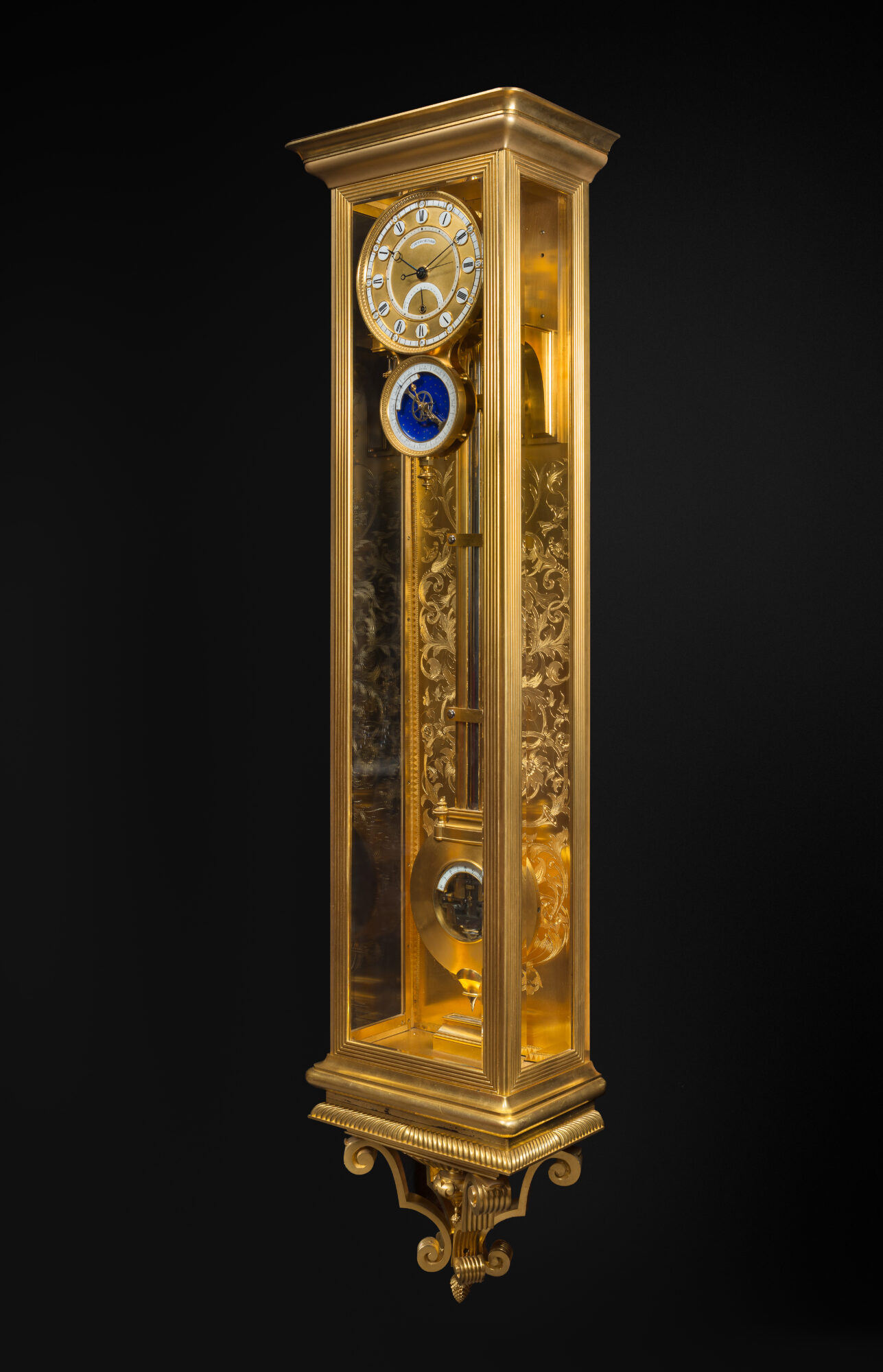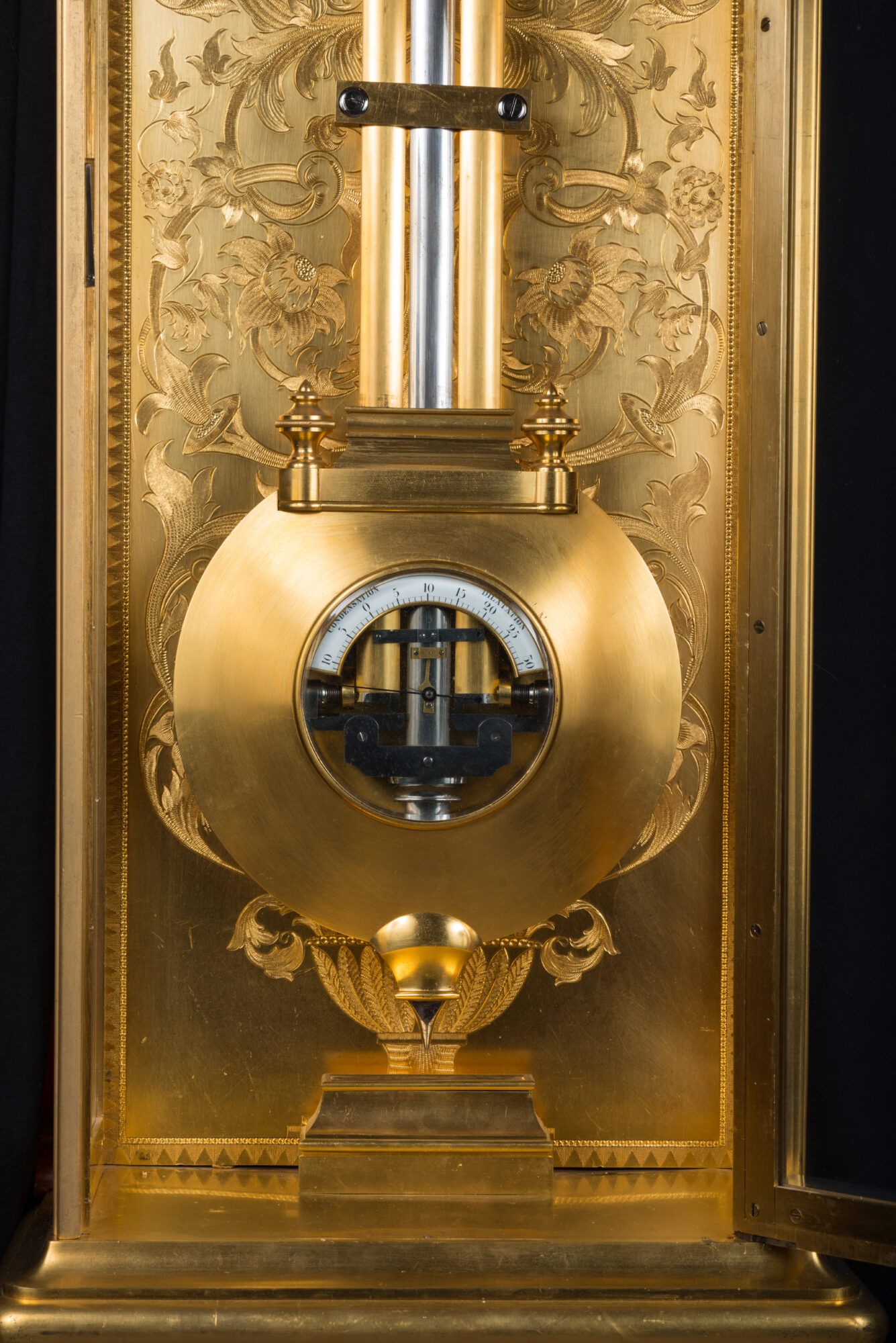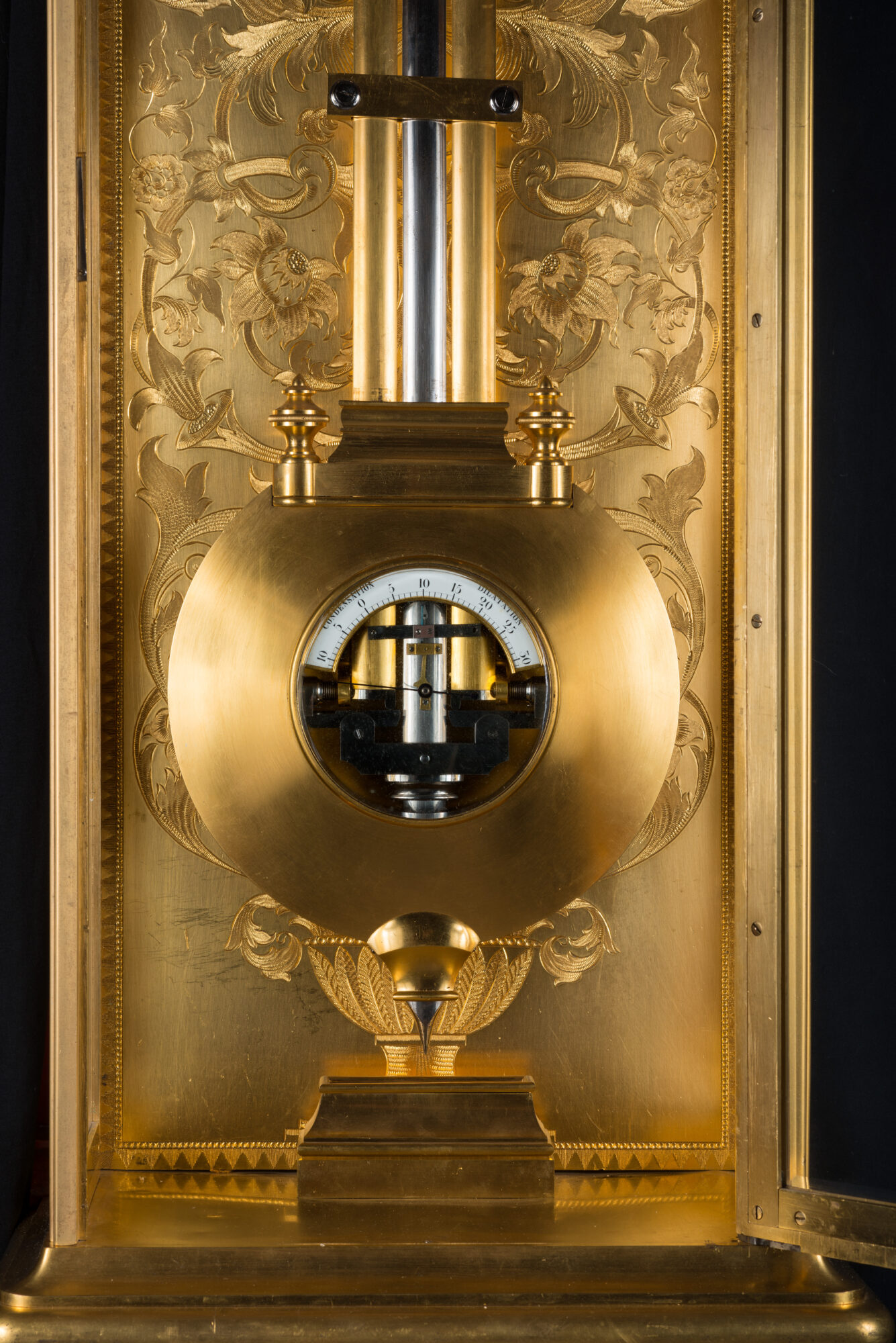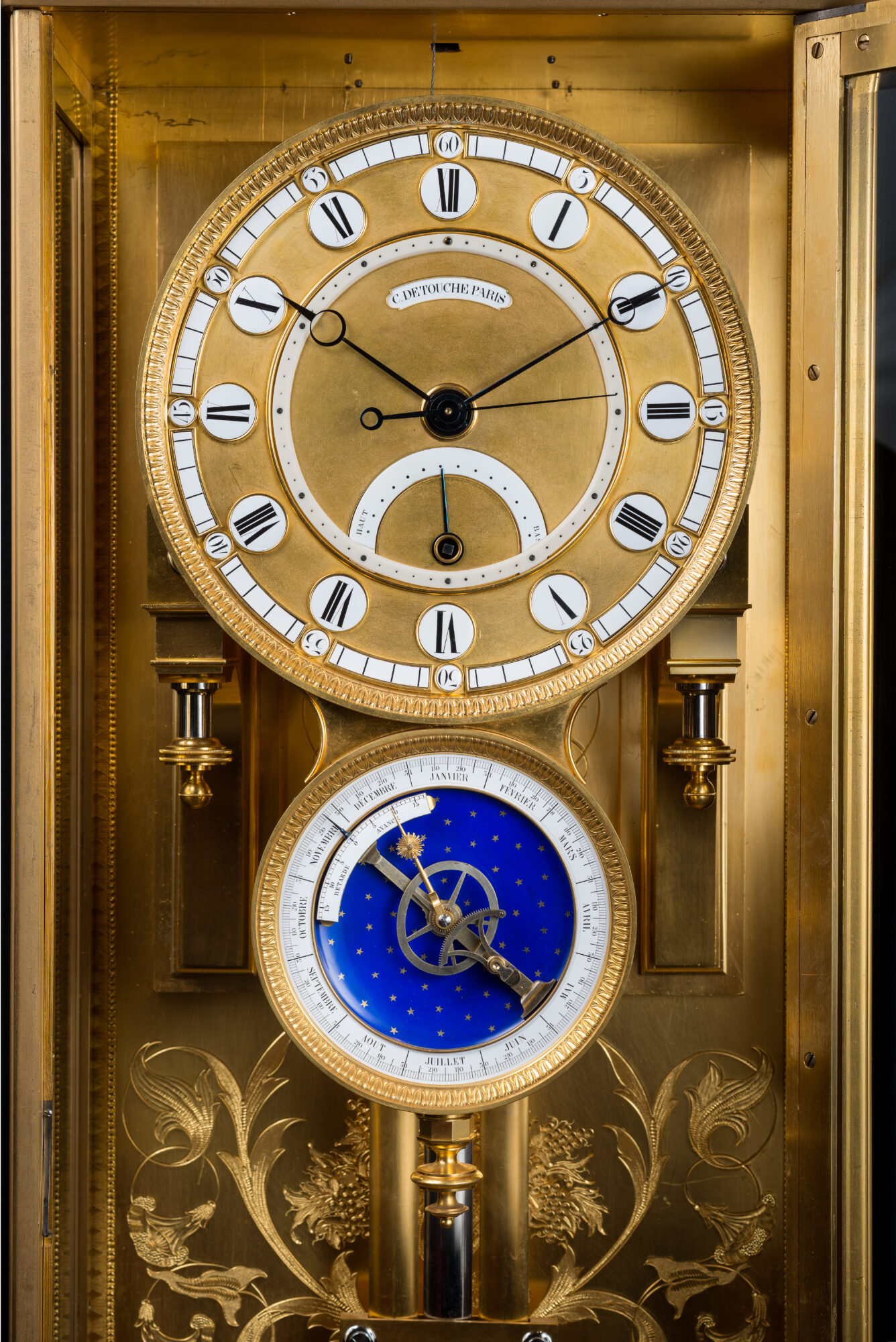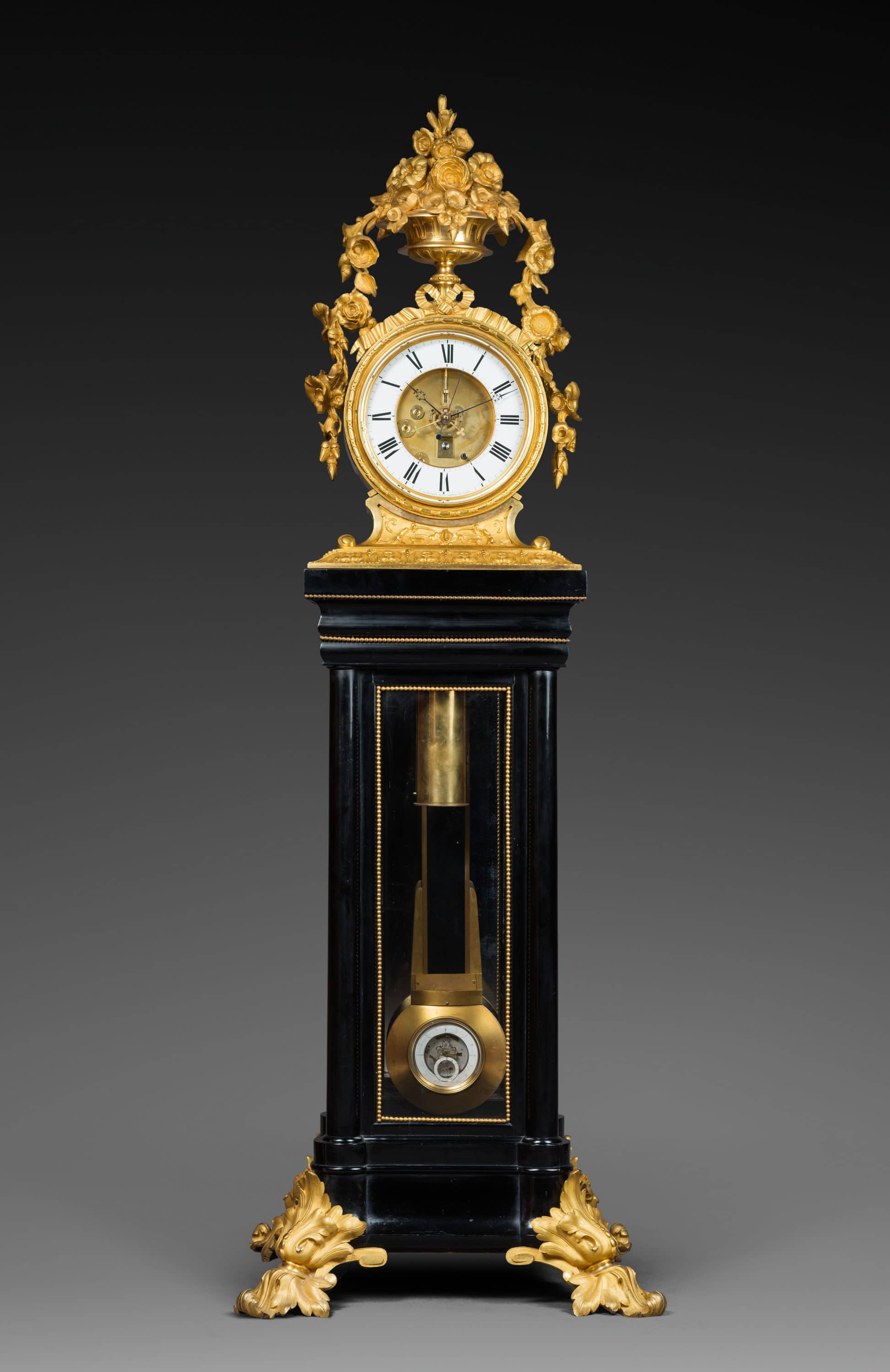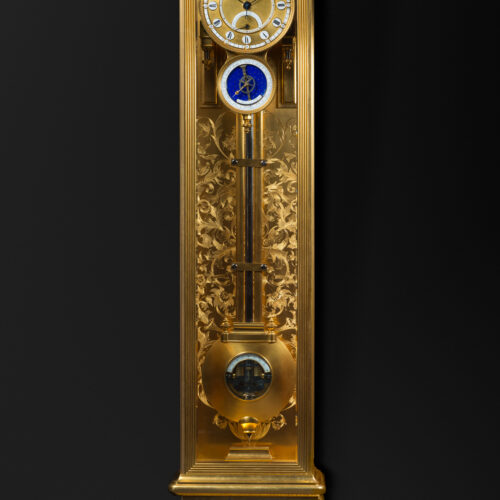Important Gilt Bronze Wall Regulator with Equation of Time, Remontoir d’Égalité, Annual Calendar and Thermometer
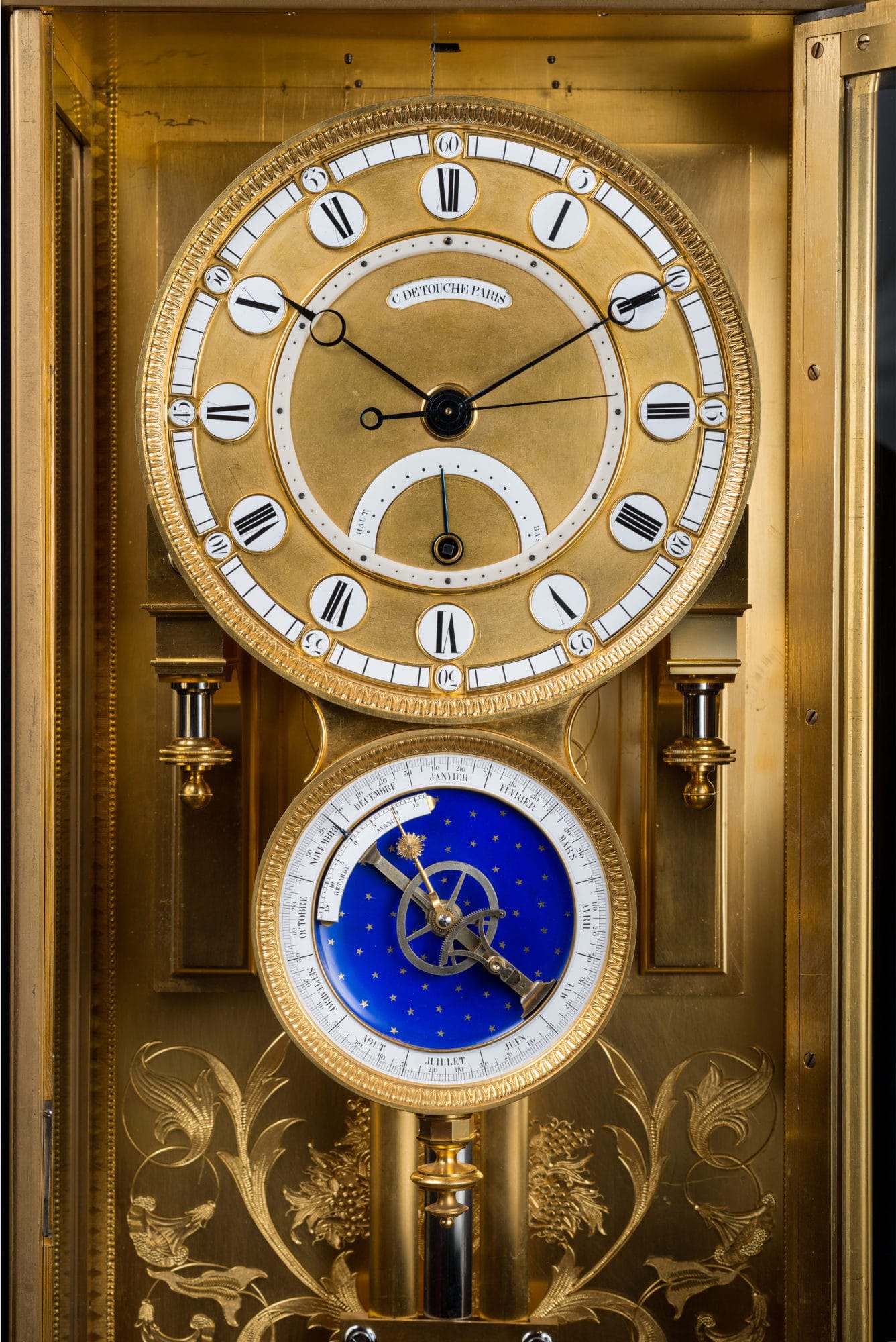
Signed by the clockmakers Louis-Constantin Detouche and Jacques-Francois Houdin
Paris, Second Empire period, dated 1851
Provenance:
– From a French private collection
A rare and important gilt bronze wall regulator by Louis-Constantin Detouche and Jacques-Francois Houdin, inscribed on the front plate under the dial: “J F Houdin 1851 Exposition de Londres Jacques-Francois Houdin”, also signed on a cartouche within the dial “C Detouche Paris” and numbered “9730”. The regulator possesses the following horological complications: power reserve, date, day of the week, month and equation of time on a sector. The main gilt brass dial enclosed by a palmetted bezel, the chapter ring with twelve large circular white enamel cartouches with black Roman numerals for the hours, an outer white enamel minute ring to include twelve smaller circular cartouches with black Arabic numerals and an inner seconds ring (later, probably bakelite), showing at six o’clock a graduated sectorial dial for the power reserve inscribed HAUT/BAS, with winding hole at the centre, with blued steel Breguet hands for the hours and minutes and blued steel pointers for the seconds and power reserve.
Below the main dial there is a secondary dial framed by a palmetted bezel with outer white enamel calendar ring showing the date of the month, the day of the week, and the month of the year with its duration (28, 30 or 31 days), centered by an annual rotating marker for the date on which is the mechanism for the equation of time, given on a white enamel sectorial dial with indications painted in black graduated from +15mn to -15mn and AVANCE/RETARD, with annual calendar and the equation kidney visible through the center, all against a gold star-studded blue enamel ground, with Breguet hands and a blued steel counter-balanced hand for the mean time and gilt brass solar hand for the real time. The 15 day going steel and brass weight driven movement with recoil anchor escapement with micrometric regulator and remontoir d’égalité and a steel and gridiron compensating pendulum placed before an engraved false plate to protect it from interferences from the descent of the weight, the massive bob centered by a thermometer with a white enamel sectorial dial with blued steel hand measuring the condensation and dilatation of the metal rods, the pendulum suspended from the top of the case by a steel cable. The rectangular glazed gilt bronze case with stepped cornice and a pierced scrolled terminal.
The present regulator features many specialized mechanisms, including the remontoir d’égalité, which applies controlled force to impulse the pendulum or balance, thus overcoming variations in timekeeping caused by variations in the driving motor. At regular intervals the remontoir winds a secondary spring or small weight, which in turns transmits a force as consistent as possible to the escapement wheel. The regulator also shows equation of time, which is the difference between solar time and mean time.
Exhibited at the 1851 Exhibition in London, this regulator was awarded a Prize Medal.
In the Official catalogue of the Exhibition, it is described as follows:
“A large regulator in a gilt brass case, with glass front and sides. It indicates the seconds and the equation of time, and has an index for the month and the day of the month. Its pendulum, which is at the same time a compensator by means of levers, was invented by one of the exhibitors. This regulator is exhibited for accuracy and workmanship”. (The Great Exhibition 1851, Report on Horological Instruments, 1851, p. 339).
Constantin-Louis Detouche (1810 - 1889)
Detouche, who was a recipient of the French Légion d’Honneur (1853) and the Danish Croix de l’ordre du Dannebrog, was official clockmaker to the city of Paris and the Emperor Napoleon III. His firm, probably the most important of its day in France, was immensely successful.
At the Nimes exhibition of 1862, the firm was described as follows: “the House of Detouche de Paris, founded in 1803; its business has increased annually and now retails in France and abroad more than 3 million francs worth of goods. In this figure, horology, from precision items to those for domestic use represent more than 1,200,000 francs. M. Detouche has already received the most prestigious awards; I will just mention: the gold medal at the Exposition Universelle d’Horlogerie at Besançon in 1860, and the gold medal in London in 1862. He was awarded La Croix de la Légion d’Honneur for his contribution toward the progress in horology that resulted from his work, the Croix de Dannebrog was awarded to him by the King of Denmark for his electric clock. Such items deserve to be described in a few details. They present improvements worthy to be known and appreciated by every clockmaker who has benefited from M. Detouche’s work and true service… The jury noted secondly a rocaille style regulator in gilt bronze of a remarkable taste, measuring 1m, 90; … The turnstiles placed at the exhibition and considered indispensable in France and abroad are also the invention of M. Detouche. All of the items shown by this company are to be noted for their modest prices, their elegance, their rich ornamentation and precision, and their skilled workmanship. The jury awards to M. Detouche a diplôme d’honneur.” (“Revue Chronométrique, 8th year, vol. IV, June 1862 – June 1863, “Exposition de Nîmes”, Paris, 1862, pp. 605-609).
In 1851, six years of Houdin’s joining the firm, Detouche exhibited at the Great Exhibition of London (the first universal exhibition), where they were categorised as “Chronometer makers, 158 and 160 rue St Martin, Paris” showing “Chronometers, large and small regulators, mathematical watchwork, watches etc”.
In 1887, toward the end of his life, Detouche funded the publication of the third edition of the “Traité d’Horlogerie Modern Théorique et Pratique” by Claude Saunier (1816-1896), also known as the C. Detouche edition (944 pages, published in Paris, and the addendum (112 pages, also published Paris).
Among Detouche and Houdin’s other prestigious creations, one should note two large astronomical regulators of differing designs, bearing numerous indications such as hours, minutes, seconds, days, months and their dates, sunrise and sunset time, the equation of time, moonrise and moonset, its phases along with its age, as well as the barometric and thermometric variations. On them the main dial is surrounded with fourteen subsidiary dials showing the time in fourteen cities across different latitudes. One of the two remained for a long time at the corner of rue Saint-Martin and rue de Rivoli and is now housed in the François-Paul Journe SA Manufacture, in Geneva.
Discover our entire collection of antique clocks on La Pendulerie Paris.
Jacques-François Houdin (1783 - 1860)
A member of several scientific associations and father-in-law to the ingenious inventor, magician-extraordinaire and horological genius Jean-Eugène Robert-Houdin (1805-71), Houdin came from Blois to Paris at Abraham-Louis Breguet’s request. Houdin devised and improved special escapements and compensating pendulums for regulators and astronomical clocks and made improvements to the machinery used in the making of wheels and pinions.
Jacques-François Houdin was Detouche’s chef d’atelier in 1845-59.
